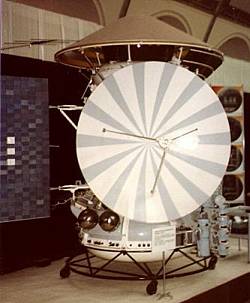Top Qs
Timeline
Chat
Perspective
4MV
Design used for Soviet space probes to Mars and Venus From Wikipedia, the free encyclopedia
Remove ads
The 4MV planetary probe (short for 4th-generation Mars-Venus probe) is a designation for a common design used for Soviet unmanned probes to Mars and Venus.
It was an incremental improvement of earlier 3MV probes and was used for Mars missions 2 to 7 and Venera missions 9 to 16. Different versions of the bus exist, for example 4V-1, 4V-M and 4V-2.[1][2] The same base design was also used for earth-orbiting space observatories.[3]
Remove ads
Design
The spacecraft bus has a height of 2.8 meters (9 ft 2 in) and a solar panel span of 6.7 meters (22 ft). The central section of the bus has a diameter of about one meter (3 ft 3 in) and contained propellant. The main engine (KTDU-425) is encircled by a conical instrument compartment with the diameter of 2.35 meters (7 ft 9 in) at the base.[4] While Mars 2,3 and Kosmos 419 used the KTDU-425, 4MV buses after 1971 used the KTDU-425A).[5]

Remove ads
Variants
- Mars M-71|3MS: Kosmos 419 (M-71|3MS No.170), Mars 2 (M-71 No.171), Mars 3 (M-71 No.172)[6]
- Mars M-73|3MS|3MP: Mars 4 (M-73|3MS No.52S), Mars 5 (M-73|3MS No.53S), Mars 6 (M-73|3MP No.50P), Mars 7 (M-73|3MP No.51P)[7][8]
- Venera 4V-1: Venera 9 (4V-1 No.660), Venera 10 (4V-1 No.661), Venera 11 (4V-1 No.360), Venera 12 (4V-1 No.361), Venera 13 (4V-1M No.760), Venera 14 (4V-1M No.761)[1][2]
- Astron: Astron[9]
- Venera 4V-2: Venera 15 (4V-2 No.860), Venera 16 (4V-2 No.861)[10]
- Granat: Granat[11]
Wikimedia Commons has media related to 4MV.
Remove ads
See also
References
Wikiwand - on
Seamless Wikipedia browsing. On steroids.
Remove ads

